It is helpful to think of white stains as "white stuff" and undefined until some testing takes place. That will keep you from buying products and spending time on an incorrect diagnosis.
Here are some things to identify first as this information may be needed later:
- Is the white stuff on top of a sealer or below it? Hint: If it comes off on your finger, it is on top.
- Did the white stuff exist before a sealer was applied? Do not seal again until the source is removed.
- If below the sealer, the sealer will need to be removed to treat it.
An easy way to tell if the "white stuff" is mineral deposits or efflorescence is the "acid test". If the white stuff "fizzes" on contact with a drop of Aldon "Grout Residue Remover" or muriatic acid (swimming pool acid), than it can be mineral deposits (see below) or efflorescence (see its page in Problem Solving) and cleaned accordingly. Do not use muriatic acid to clean or you could cause some damage.
Tip about sealed surfaces: typically efflorescence would be below the sealer (not in it) because it comes up from inside. Mineral deposits would be on top of the sealer as residue of drying water. If on top, it will wipe off. If below the surface, the sealer needs to be removed to access the white stuff for treatment unless Efflorescence Treatment is able to penetrate through the sealer.
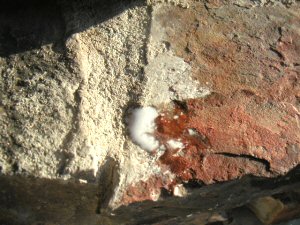
|
Acid fizzing on contact with cement grout smear on a piece of stone This fizzing reaction is similar on true efflorescence powder or crystals If you do see the fizzing reaction, see "Problem Solving" for "Efflorescence" and for "Mineral Deposits". |
The lack of a fizzing reaction says it is something else entirely, or the minerals involved in this type of situation are not the usual type that do fizz, or something is coating the white stuff and keeping the acid from contacting it. Therefore, mineral deposits and/or efflorescence are not ruled out - but the cleaning might involve other cleaning techniques. Try lacquer thinner , abrasion with a cleanser, sanding.The lack of a fizzing reaction can also mean that the white stuff is a coating that is breaking down (a sealer or top coating sealer protector). This does not happen with Aldon products if they are applied per the product label directions.
You might not know that a sealer was present. Sometimes installers use a sealer to keep grout from sticking to the face of the surfacing.If you do see the fizzing reaction, see "Problem Solving" for "Efflorescence" and for "Mineral Deposits".
- If you think it is a top coating type product (usually a water based acrylic), it should remove with Aldon "Insta-Clean"
without hurting the underlying sealer, assuming the underlying sealer is an Aldon product. If the underlying sealer is not an Aldon sealer, be cautious and test first. You can also try "an ammoniated wax stripper for resilient tile" from the supermarket as these are too weak to effect a good sealer, but strong enough to remove a breaking down top coating. 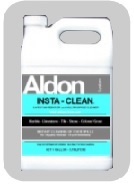
- If you think it is a sealer (or sealer and top coating), you will need to remove it all with
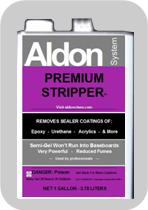
In Showers:
Hard water mineral deposits - see belowSoap scum - Aldon "Grout Restoration" will remove soap scum, mineral deposits, mold, rust, etc.
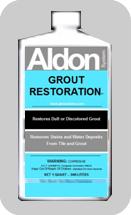
If the surface is marble or limestone and you are concerned about using an acidic cleaner, use
Hazy residue after a cleaning or stain removal process:
This can be hard water mineral deposits from your rinse water. To find out, take a little of the same water from the exact same source tap as used on the project. Let 1/8" evaporate from a glass until dry. The minerals will be left behind in the same way they were left on your floor.Hazy, Cloudy Looking Under SealerRemove mineral deposits as discussed above (you can also use Aldon "Grout Residue Remove" if you already have it), but you need to do something about the rinse water. If it is not practical to use non-mineral containing water - test cleaning very small areas that you can immediately wipe dry. Note that even softened or treated water can contain minerals.
See "FAQ Sealers".
Powdery Looking, Coming From Below The Surface
See efflorescence page.
White Deposits On Top Of:
- A sealer (with or without a layer of Lifeguard or Tile Cover)
- An unsealed, non-absorbent surface
- An absorbent surface
(Including from flower pots, roof water shedding, garden runoff)
Inside:
Probably mineral deposits left behind by hard water used in mop water. Remove with
Outside:
If coming from sprinklers or rain water runoff it is usually hard water mineral deposits, not efflorescence. Efflorescence only comes from below the surface. Test by capturing the water on a plate or piece of glass and allow it to evaporate dry. If the same white residue is left behind, consider it to be water deposits. These are easily cleaned off as often as desired with Aldon "Grout Restoration", or for heavier duty cleaning "Grout Residue Remover",

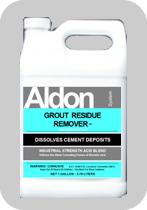
White Deposits, But Your Not Sure If They Are On Top, Inside, Or Below The Sealer
Test an area with "Grout Residue Remover".

Use Aldon "Premium Stripper" to remove a test section of sealer.

If the white is left on the surface after the sealer is removed, it is obviously coming from beneath the surface and was trapped below the sealer. To confirm, apply some "Grout Residue Remover" to the remaining white staining. If it "fizzes" and is eaten away, it is efflorescence.
White Areas That Are Not Any Of The Above
It could be a non-Aldon sealer peeling. See "FAQ Sealers".
Sometimes cleaning is a trial and error process. The cause of the problem might be different than thought, or have multiple causes and results that must be handled in steps. In rare cases, it cannot be cleaned. Proceed as though it is an experiment whose results must be evaluated.
Any Aldon cleaner has more than one purpose. It is not limited to only this cleaning project.